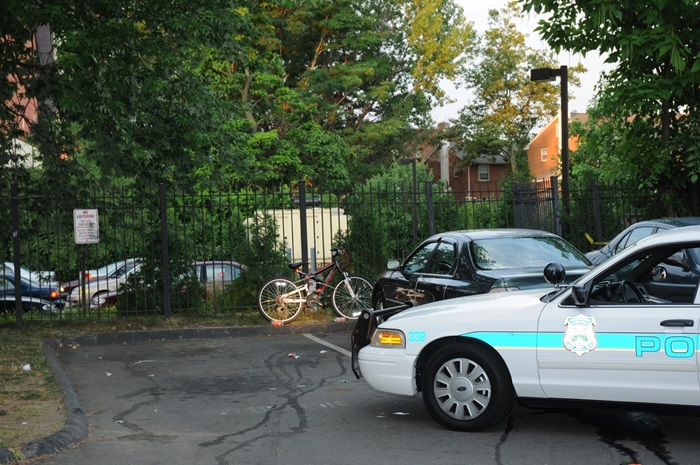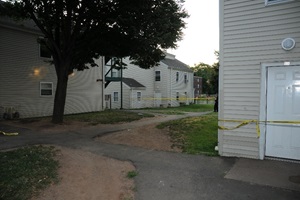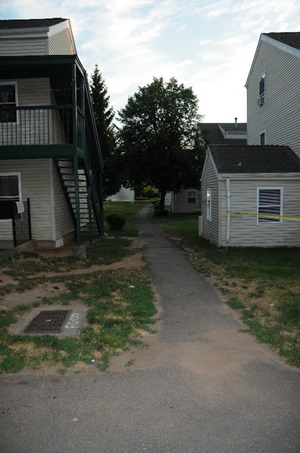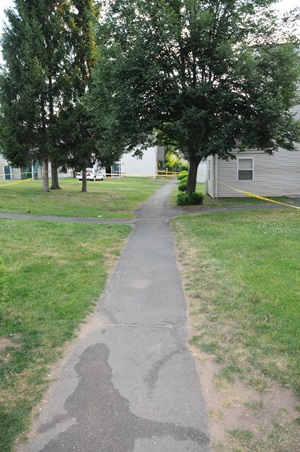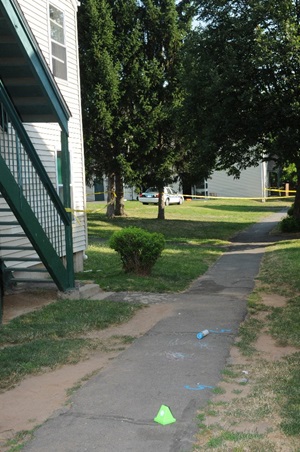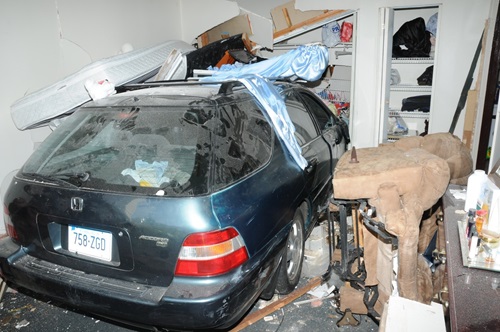Report of the State’s Attorney for the Judicial District of Hartford Concerning the Use of Deadly Physical Force Resulting in the Death of Ernesto Morales on July 11, 2012
Legal Authority | Introduction | Circumstances of the Incident | Office of the Chief Medical Examiner | Ernesto Morales | Martin Caceres | Moises Serrano | Trajectory Report | Officer William Cote | Officer Kenneth Medina | Casa Verde Surveillance Video | Hartford Police Department General Order 20 | Applicable Law and Analysis | Conclusion | Exhibits
Legal Authority for the Report
Connecticut General Statutes Section 51-277a provides:
(a) Whenever a peace officer, in the performance of such officer’s duties, uses physical force upon another person and such person dies as a result thereof, the Division of Criminal Justice shall cause an investigation to be made and shall have the responsibility of determining whether the use of physical force by the peace officer was appropriate under section 53a-22. The division shall request the appropriate law enforcement agency to provide such assistance as is necessary to determine the circumstances of the incident.
This State’s Attorney is mindful of the policy enacted by the Council of State’s Attorneys whereby a State’s Attorney other than the State’s Attorney for the jurisdiction where the use of deadly force incident occurred would be responsible for such investigations. However, as this incident occurred prior to the policy change, the undersigned State’s Attorney remained responsible for this report.
On July 11, 2012, at approximately 2:00 a.m., the Hartford State’s Attorney’s Office was notified of a use of deadly physical force incident involving an officer of Hartford Police Department’s Southwest Conditions Unit. The incident occurred in the parking lot of the Casa Verde apartments at 60 Wadsworth Street at approximately 1:00 a.m. and resulted in the death of 30 year old Ernesto Morales. In accordance with the policy of the Hartford State’s Attorney, inspectors from this office responded to the scene and requested that the Connecticut State Police be the lead investigative agency. Central District Major Crime Squad responded and commenced a comprehensive and thorough investigation, which included processing the entire scene including two vehicles, the apartment where the stolen motor vehicle came to a rest and the parking lot and courtyard of 60 Wadsworth Street.
State Police made contact with the family of the deceased and attended the post-mortem examination. State Police investigators canvassed the complex for witnesses and seized the assigned handguns, duty uniforms, duty belts and equipment and administered gunshot residue kits to the officers involved in the incident. The Hartford Police cruiser that the officers occupied while patrolling was not equipped with in dash cameras; and the officers were not outfitted with body worn cameras. Surveillance videos were seized from Casa Verde Apartments that captured the officers’ arrival, the discharge of the firearm and the operation of the stolen motor vehicle. All forensic and ballistic evidence was processed through the Department of Emergency Services and Public Protection Forensic Science Laboratory. Upon completion of their investigation, State Police turned over casebooks to the State’s Attorney’s Office on March 13, 2014.
Circumstances of the Incident:
Hartford Police Officers Robert Iovanna, Kenneth Medina, Kenneth Labbe and William Cote, Jr., prepared reports of their involvement in this incident and provided them to Connecticut State Police. Their reports reveal the following:
On July 11, 2012, at approximately 1:00 a.m., Hartford Police Officers Robert Iovanna, Kenneth Medina, Kenneth Labbe and William Cote, Jr., members of department’s Southwest Conditions Unit, were on proactive patrol in the area of Park and Wadsworth Streets. The Southwest Conditions Unit is a group of uniformed officers responsible for the enforcement of quality of life issues including, but not limited to, loitering, trespassing, public drinking, drug offenses and motor vehicle enforcement in the southwest area of Hartford. Officers describe the area of Park and Wadsworth Street as a “high crime” area based upon numerous arrests for drug offenses and other quality of life offenses. The four officers were dressed in readily identifiable police uniforms and were in a marked Hartford Police Department cruiser, # 332. Officer Labbe was driving the cruiser. Officer Cote was in the rear driver’s side seat, Officer Medina in the front passenger seat and Officer Iovanna in the rear right passenger seat.
While on patrol, officers observed a black male, known to them from past drug investigations as Jerome Wetherspoon, operating a mountain bike after dark with no illumination device. Officers told Wetherspoon he was violating the law at which time they observed him travel north on Wadsworth Street to 60 Wadsworth Street, the south entrance of the Casa Verde Apartments. Approximately one minute later, Wetherspoon returned on foot, walking south on Wadsworth Street. Knowing from their training and experience that drug dealers often conceal their drugs in and around their bicycles to avoid detection, officers entered the south parking lot of 60 Wadsworth Street in an attempt to find the bicycle.
Officer Labbe drove to the farthest side (the east side) of the parking lot but did not see the bicycle until he started to back the cruiser up. Officers saw the bicycle behind parked vehicles along a black iron fence at the southeast corner of the lot. (Exhibit 1) Officer Labbe angled the cruiser “nose to nose” toward a green Honda Accord station wagon, which was backed into the extreme southwest parking space in the lot. Using the cruiser’s spotlight to illuminate the area, Officer Medina exited the cruiser to inspect the bicycle. As he walked between the cruiser and the Honda, Officer Medina observed three people in the vehicle. The two front occupants had both seats completely reclined and were lying flat. Officer Medina shined his flashlight into the car and recognized the rear passenger from previous police encounters as Moises Serrano. Serrano and the front passenger were known to Officer Medina for their involvement in drug dealing in the Park and Zion Street areas. He did not recognize the operator of the vehicle.
Based upon Officer Medina’s training and experience, drug dealers often carry firearms to protect their drugs and money so he drew his service weapon and shouted, “Show me your hands.” Officer Cote approached the Honda from the front. Officer Iovanna exited the cruiser and stood at the driver’s side of the Honda and drew his service weapon. Officer Medina was on the passenger side of the vehicle with all officers yelling commands for the occupants to show their hands.
Officer Labbe positioned the cruiser in a manner to prevent the Honda from leaving and to prevent the operator of the Honda from striking the officers. At that point, the operator of the Honda sat up and reached for something on the floor. Officer Cote heard the engine turn on and “rev,” as the operator of the Honda looked straight at him. Officer Iovanna yelled, “he’s gonna go, he’s gonna go.” At that point, the operator of the Honda quickly accelerated forward spinning and squealing the tires on the vehicle and striking the front of the cruiser. At that point, the Honda’s rear passenger, Moises Serrano, exited the vehicle and fell to the ground. He was secured in handcuffs. The Honda’s operator then put the car in reverse and turned the steering wheel in an attempt to get around the cruiser and then placed the car in drive. The operator of the Honda drove around the cruiser in the direction of Officer Cote and Officer Medina. As Officer Cote noted in his report, he feared that the vehicle would cause serious physical injury or death to himself or Officer Medina, so he fired his service weapon several times at the operator of the Honda and moved to the right to avoid being struck by the vehicle. The vehicle continued to accelerate and continued northeast onto the sidewalk, then the grass before turning north and driving through the courtyard area of the complex between the apartment buildings in an area designed for pedestrian access only. (Exhibit 2)
Officer Cote ran after the Honda, which hit one of the apartment buildings, crashing through the building’s exterior and coming to rest inside one of the apartments. (Exhibit 3) As the Honda’s engine continued to “rev,” heavy, white smoke filled the apartment. Because the Honda was still in gear, the tires were still spinning and there was an odor of burning rubber. As Officer Cote approached the Honda, two females ran outside through the rear door of the apartment.
Officer Medina also pursued the vehicle on foot and entered the apartment using the door through which the females exited. He had to kick open the door to gain access to the room where the vehicle was located. According to one of the women inside the apartment, moments earlier her mother had been in that room before leaving to change into her pajamas.
Other Hartford Police officers converged on the area in response to a “10-0” (Officer Needs Assistance) call. Officer Cote reported to his sergeant that he discharged his firearm and that he was experiencing a soreness in his throat due to the exposure to smoke. He was transported to Hartford Hospital where he was treated and released.
With the assistance of other Hartford Police officers, the front seat passenger of the vehicle was removed from the vehicle. He had apparently sustained a gunshot wound to the left flank but he was alert and conscious. He was treated at the scene and then transported to the hospital by ambulance where he was treated for non-life threatening injuries. The operator of the vehicle was motionless. Officer Medina grabbed his right arm, which was limp. Once the car was turned off and the tires stopped spinning, the smoke thinned. Officer Medina noted that the operator of the Honda sustained a gunshot wound to the lower jaw area. His eyes were open and motionless. Officer Medina felt for a pulse with negative results. The operator was pronounced dead at the scene by emergency medical workers and identified through his fingerprints as Ernesto Morales, date of birth 10/23/1981. Morales’ mother and sister were notified of his death on July 12, 2012 by Connecticut State Police.
Office of the Chief Medical Examiner:
A post-mortem examination was performed by Chief Medical Examiner Dr. H. Wayne Carver on July 12, 2012. The examination revealed that Morales sustained six gunshot wounds:
- A gunshot wound of the face with entry on the left corner of the mouth;
- A gunshot wound of the left anterior chest;
- A grazing gunshot wound of the exterior aspect of the left forearm;
- A grazing gunshot wound on the flexor aspect of the forearm, on the ulnar side;
- A gunshot wound in the anterior aspect of the right shoulder with the wound tract entering the chest cavity;
- A gunshot wound on the back of the left shoulder.
Toxicology analysis showed positive results for cocaine and phencyclidine (PCP). Dr. Carver certified the cause of death of Ernesto Morales as multiple gunshot wounds and the manner of death as homicide.
Ernesto Morales (D.O.B. 10/23/1981)
Ernesto Morales was thirty years old at the time of his death. Connecticut State police spoke to his father and sister regarding their last contacts with him. His father stated that Ernesto dropped by unexpectedly at approximately 9:00 p.m. on July 10, 2012, and had dinner. He left approximately forty five minutes later stating that he was going to his sister’s house. He said that Ernesto got into a dark green colored vehicle.
Ernesto’s sister, Maria Marrero, stated that Ernesto dropped by her house on July 9, 2012, and July 10, 2012. Although she knew that her brother smoked crack, he appeared “clean” on the nights that she saw him. She said that he told her that he had just come from their father’s house where he had dinner. He asked for money and she gave him $20.00. She stated that he was driving a dark colored vehicle. Ms. Marrero stated that Ernesto had told her during his visit on either July 9 or July 10 that he thought Hartford Police had a warrant for his arrest for a domestic incident and that he had no intention of turning himself in.
In fact, Ernesto Morales had an outstanding warrant for Breach of Peace and an active restraining order. He had a criminal history for robbery, assault, threatening, burglary, larceny, possession of narcotics, violation of probation and several additional misdemeanors.
Martin Caceres (D.O.B. 01/11/1977)
Martin Caceres was the front passenger in the green Honda station wagon. Hospital records revealed that he sustained a gunshot wound to the abdomen, grade four splenic injury, through and through gastrostomies and a small bowel injury. Toxicology records reveal that he tested positive for cocaine. He underwent emergency surgery and was discharged from Hartford Hospital on July 18, 2012.
Caceres was interviewed by Connecticut State Police while he was hospitalized. He stated that after he got out of work, he went to 60 Wadsworth Street to buy crack cocaine as he had done in the past. He stated that after purchasing the drug, an unknown male asked if he was willing to share. He followed the male to a green four-door car where they all smoked crack. He said that shortly thereafter, a spotlight from a police cruiser illuminated the car so he and the driver lowered their seats. He said police approached the car with guns drawn and ordered them to get out of the car. He said the driver started the ignition and the doors locked. When he asked the driver what he was doing, the driver said the car was stolen and put the car into drive.
Moises Serrano (D.O.B. 12/05/1971)
Moises Serrano was the rear seat passenger of the Honda Accord who exited the vehicle after the operator started the engine. He gave a statement to Connecticut State Police concerning his involvement with the occupants of the car. He confirmed that he did not live at the Wadsworth Street complex but that he frequented the location to smoke crack and marijuana. He stated that on July 11, 2012 at approximately 1:00 a.m., he was walking through the complex when he saw a green Honda. The headlights flashed and he walked over to the vehicle where he saw a Mexican male, with whom he previously looked for crack, sitting in the front passenger’s seat. He said that he got into the rear passenger seat to smoke crack with them. He did not know the driver. He said that he was only in the car for a couple of minutes and that they had not even started to smoke crack when Hartford Police showed up with guns drawn and ordered them to get out of the car. He said he got out of the car when the operator said that he was “pulling off.” He said that he saw the Honda hit the police cruiser before driving onto the sidewalk behind the building.
The 1997 Honda Accord was reported stolen on July 9, 2012. State Police seized the keys from the ignition. Found within the car were crack pipes and expended bullet-like projectiles. They were also seized. As part of the processing of the Honda, State Police documented bullet strikes to determine the trajectory angle. A total of six suspected bullet strikes were located but trajectory determinations were only able to be made for three bullet strikes on the windshield. Three additional suspected bullet strikes were identified: two in the front driver’s side window and one in the rear driver’s side window.
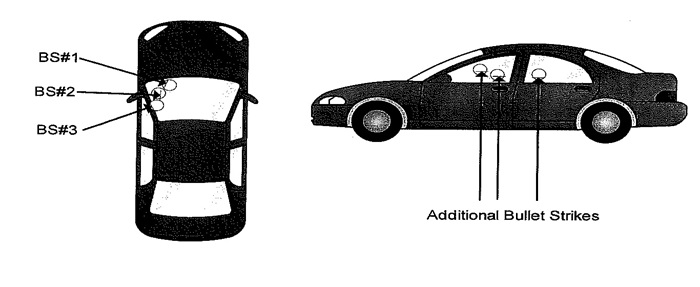

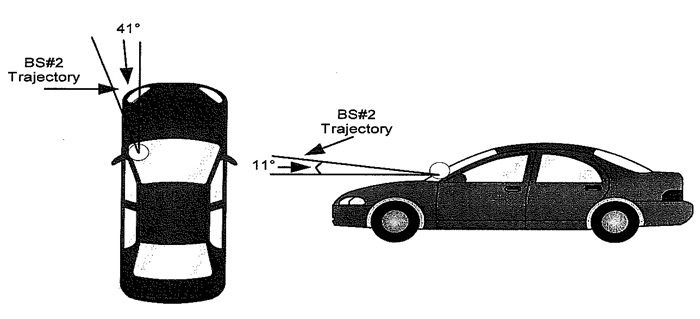
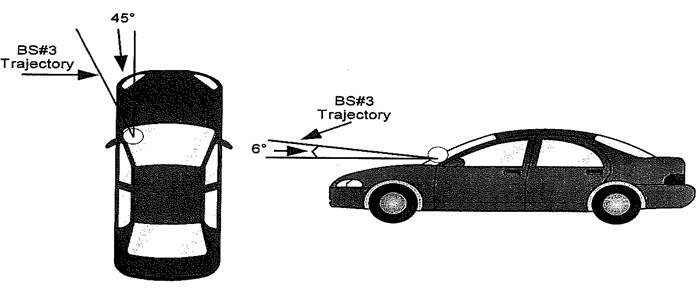
Connecticut State Police seized a Smith and Wesson, Model M & P 45, semi-automatic handgun, bearing serial number HPD0483, with a magazine and four “win” .45 auto cartridges from Officer Cote. They seized seven expended shell casings from the scene. Microscopic comparison of the cartridge cases to test-fired cartridge cases from Officer Cote’s department-issued firearm revealed excellent striations within the firing pin drag marks. It was determined that all seven cartridge cases were fired from his firearm. Additionally, six fired projectiles were seized and sent to the Forensic Science Laboratory. A microscopic comparison was made between the seized projectiles and test-fired projectiles from Officer Cote’s firearm. It was determined that the evidence projectiles were fired from Officer Cote’s firearm.
Connecticut State Police investigators conducted gunshot residue collection testing by swabbing the left and right hands of Officers Medina, Labbe, Iovanna and Cote, and sent the collection kits off to the state laboratory. Officer Cote’s collection kit results showed the presence of a particle containing the elements of lead barium and antimony on a sample marked “right back.” The “left back” failed to detect the presence of a particle containing any of the three elements. The “left palm” detected a particle containing the elements of barium and antimony. The “right palm” detected the presence with a particle containing the element “lead.” The results corroborate Officer Cote’s statement that only he discharged his firearm.
At the time of this incident Officer Cote’s firearm qualifications were up to date and he had completed all necessary training. (He had) His disciplinary history consisted of one sustained complaint of Improper Handling of a Prisoner’s Property.
On July 11, 2012, at approximately 6:34 a.m., and in the presence of his attorney, Officer Medina agreed to do a “walk-through” of the scene with Connecticut State Police. He recounted the details of the investigation that brought the officers to the Casa Verde Apartments, and confirmed where the four officers were seated in the cruiser. He explained where he was standing, on a grass area between the southeastern most parking spot and an apartment building, leaving him at the front passenger quarter panel area of the suspect vehicle, to attempt to get a better view through the front window of the suspect vehicle. This description placed him at a point where State Police investigators identified tire marks from the suspect vehicle fleeing the scene. Further, the tire marks on the curb corroborated his statements. Officer Medina didn’t recall specifically where Officer Cote was, but knew that he was behind him. He stated that the suspect vehicle accelerated quickly, squealing its tires, and drove up over the curb in his direct path and that of Officer Cote. He stated that the vehicle struck his hand and that he came within a foot of being struck by the car. It was at this point that he heard gunshots being fired. He observed the vehicle drive north into the courtyard area, and assisted in securing the rear passenger who was now out of the car.
Casa Verde Surveillance Video:
Connecticut State Police investigators obtained video surveillance from the Casa Verde Apartments. The video depicts the Hartford Police cruiser as it enters the southwest parking lot of the Casa Verde Apartments and approaches the suspect vehicle. An officer is seen drawing his duty weapon and pointing it in the direction of the suspect vehicle. The officers are seen surrounding the suspect vehicle with their duty weapons drawn, and the suspect vehicle is seen colliding with the cruiser. The officers appear to be in the direct path of the suspect vehicle, and it appears that one of the officers who is in the direct path has smoke coming from his firearm, leading investigators to believe that it was at this point that the officer fired upon the suspect vehicle.
Hartford Police Department General Order 1-20:
Hartford Police Department General Order 1-20, Section III-A (1)
Provides for the use of firearms to defend the officer or another officer from the use or imminent use of force that can reasonably be expected to cause death or serious physical injury.
General Order 1-20, Section III-A(2)
Allows for the officer’s use of his firearm to effect the arrest or to prevent the escape of a person the officer reasonably believes has committed a felony, which involves the infliction of serious physical injury or death, provided the officer has identified himself and announced his intention to use deadly force.
General Order 1-20 Section III-B
Prohibits the use of firearms to fire at a moving vehicle, unless the occupants of the vehicle are using deadly force against the officer or another person.
General Principles
General Statutes §53a-22 (c) provides: “A peace officer…is justified in using deadly physical force upon another person…only when he or she reasonably believes such to be necessary to …(d)efend himself or herself or a third person from the use or imminent sue of deadly physical force, (or to) effect an arrest or prevent the escape from custody of a person whom he or she reasonably believes has committed or attempted to commit a felony which involved the infliction or threatened infliction of serious physical injury and if, where feasible, he or she has given warning of his or her intent to use deadly physical force.”
“Serious physical injury” is defined as “physical injury which creates a substantial risk of death, or which causes serious disfigurement, serious impairment of health or serious loss or impairment of the function of any bodily organ…” General Statutes §53a-3(4).
“(T)he reasonableness of (an officer’s) belief under §53a-22 should be evaluated pursuant to (a) subjective-objective formulation. Under that test, the jury must first determine whether, on the basis of all the evidence, the (officer) in fact honestly believed that deadly force, rather than some lesser degree of force, was necessary to repel the victims alleged attack…if the jury determines that the (officer) honestly believed that deadly force was necessary, it then turns to the second, or ‘objective,’ part of the test. Here, the jury’s inquiry requires it to determine whether the (officer’s) honest belief was reasonable.” State v. Smith, 73 Conn. App.173, 185, (2002)
The United States Supreme Court has held that “the reasonableness of a particular use of force must be judged from the perspective of a reasonable officer on the scene, rather than with the 20/20 vision of hindsight.” Graham v. Connor, 490 U.S. 386, 396 (1989). In determining reasonableness, a trier must account for the fact that “police officers are often forced to make spilt-second judgements-in circumstances that are tense, uncertain, and rapidly evolving-about the amount of force that is necessary in a particular situation.” Id. at 396-97.
The United States Supreme Court has identified several factors relevant in analyzing an officer’s reasonableness: “(0) the severity of the crime at issue, (ii) whether the suspect poses an immediate threat to the safety of the officers or others, (ii) and whether he is actively resisting arrest or attempting to evade arrest by flight.” Id. at 396.
With regard to the objective part of the test. “(t)he ‘reasonableness’ of a particular use of force use be judged from the perspective of a reasonable officer on the scene, rather than with the 20/20 vision of hindsight.” Graham v. Connor, 490 U.S. 386, 396 (1989). “The calculus of reasonableness must embody allowance for the fact that police officers are often forced to make split-second judgements—in circumstances that are tense, uncertain, and rapidly evolving—about the amount of force that is necessary in a particular situation.” Id. at 396-97. The question is whether the officers’ actions are ‘objectively reasonable’ in light of the facts and circumstances confronting them, without regard to their underlying intent or motivation.” Id. at 397. In State v. Smith, our Appellate Court defined the subjective-objective test for evaluating self-defense under General Statutes §53a-22. 73 Conn. App. at 185-86. Consistent with the rule of Graham v. Connor, the Court held that, “In addressing the objective part of the test …, the standard is that of a reasonable peace officer.” Id. at 185 n.5.
On July 11, 2012, approximately 1:00 a.m., officers assigned to the Hartford Police Southwest Conditions Unit were investigating an area known to them from drug investigations. The investigation led them to the Casa Verde Apartments at 60 Wadsworth Street, a location also known for drug activity. While conducting their investigation, the officers observed a green Honda Accord occupied by three males who tried to hide themselves from police. Officers knew two of the occupants from past drug investigations. Officers Robert Iovanna, Kenneth Medina, Kenneth Labbe and William Cote Jr., surrounded the vehicle yelling for the occupants to show their hands. The operator of the car, Ernesto Morales, turned the engine on, “revved” it and put the car in “drive,” driving directly into the path of the officers causing Officer Cote to have to jump out of the way to avoid being hit, and seriously injured or killed. As Officer Cote stated in his report, the actions of the operator, in accelerating in his direction, left him in fear of his life and that of Officer Medina, so he fired his department-issued firearm, striking Ernesto Morales. The beliefs of Officer Cote were those that any reasonable police officer would have had, and were thus, subjectively reasonable, faced with the same threat. His resulting action in discharging his firearm was objectively reasonable and, thus, appropriate under Connecticut General Statutes Section 53a-22(c) The actions of Officer Cote are therefore justified and the Division of Criminal Justice will take no further action.
Respectfully submitted,
Gail P. Hardy
Hartford State’s Attorney
